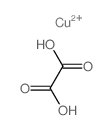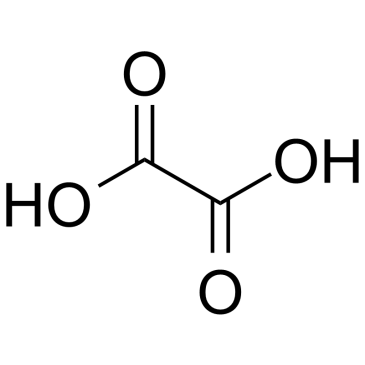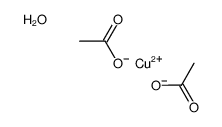Cupric oxalate

Cupric oxalate structure
|
Common Name | Cupric oxalate | ||
|---|---|---|---|---|
| CAS Number | 814-91-5 | Molecular Weight | 153.58100 | |
| Density | N/A | Boiling Point | 365.1ºC at 760 mmHg | |
| Molecular Formula | C2H2CuO4++ | Melting Point | N/A | |
| MSDS | N/A | Flash Point | 188.8ºC | |
| Name | Oxalic acid copper(2+) salt (1:1) |
|---|---|
| Synonym | More Synonyms |
| Boiling Point | 365.1ºC at 760 mmHg |
|---|---|
| Molecular Formula | C2H2CuO4++ |
| Molecular Weight | 153.58100 |
| Flash Point | 188.8ºC |
| Exact Mass | 152.92500 |
| PSA | 74.60000 |
| Water Solubility | insoluble |
|
Section 1: Product Identification Chemical Name:Copper (II) oxalate hemihydrate CAS Registry Number:814-91-5 Formula:CuC2O4.0.5H2O EINECS Number:none Chemical Family:salt of an organic acid Synonym:copper oxalate, Oxalic acid, copper salt.
Section 2: Composition and Information on Ingredients IngredientCAS NumberPercentACGIH (TWA)OSHA (PEL) Title Compound814-91-5100%1mg/m3 (as Cu)1mg/m3 (as Cu) Section 3: Hazards Identification Soluble oxalates are harmful if swallowed. They precipitate calcium from the bloodstream causing violent Emergency Overview: muscular stimulation, convulsions, collapse, and death. Primary Routes of Exposure:Ingestion, Inhalation of dust. Eye Contact:May cause moderate to severe irritation of the eyes. Skin Contact:May cause moderate to severe irritation of the skin. Inhalation:Dust may be severely irritating to the nose, mucous membranes and respiratory tract. Ingestion:Ingestion may cause vomiting, pain, violent muscular stimulation, convulsions, collapse, and death. Soluble oxalates remove calcium from the bloodstream. This interferes with the central nervous system Acute Health Affects: causing violent convulsions and death. Large amounts of copper salts are toxic when ingested. Prolonged exposure to oxalates can lead to kidney failure resulting from calcium oxalate precipitation in renal Chronic Health Affects: tubes. Copper compounds may cause liver and kidney disease. NTP:No IARC:No OSHA:No SECTION 4: First Aid Measures Immediately flush the eyes with copious amounts of water for at least 10-15 minutes. A victim may need Eye Exposure: assistance in keeping their eye lids open. Get immediate medical attention. Wash the affected area with soap and water. Remove contaminated clothes if necessary. Seek medical Skin Exposure: assistance if irritation persists. Remove the victim to fresh air. Closely monitor the victim for signs of respiratory problems, such as difficulty Inhalation: in breathing, coughing, wheezing, or pain. In such cases seek immediate medical assistance. Antidotes are said to be soluble calcium given orally, and calcium gluconate given intravenously, to be Ingestion: administered by trained medical personnel. Keep the victim calm. Give the victim water (only if conscious). SECTION 5: Fire Fighting Measures Flash Point:not applicable Autoignition Temperature:none Explosion Limits:none Extinguishing Medium:carbon dioxide, dry powder or foam If involved in a fire, fire fighters should be equipped with a NIOSH approved positive pressure self-contained Special Fire Fighting Procedures: breathing apparatus and full protective clothing. Hazardous Combustion andIf involved in a fire this material may emit toxic organic fumes. Decomposion Products: Unusual Fire or Explosion Hazards: No unusual fire or explosion hazards. SECTION 6: Accidental Release Measures Spill and Leak Procedures:Small spills can be mixed with vermiculite or sodium carbonate and swept up. SECTION 7: Handling and Storage Handling and Storage:Store in a sealed container. Keep away from heat and moisture. SECTION 8: Exposure Controls and Personal Protection Eye Protection:Always wear approved safety glasses when handling a chemical substance in the laboratory. Skin Protection:Wear appropriate chemical resistant gloves and protective clothing. Ventilation:Material may form a fine dust. If possible, handle the material in an efficient fume hood. If in form of fine dust and ventilation is not available a respirator should be worn. The use of respirators Respirator: requires a Respirator Protection Program to be in compliance with 29 CFR 1910.134. Ventilation:Material may form a fine dust. If possible, handle the material in an efficient fume hood. Additional Protection:No additional protection required. SECTION 9: Physical and Chemical Properties Color and Form:blue pwdr. Molecular Weight:151.57 (160.57) Melting Point:no data Boiling Point:no data Vapor Pressure:no data Specific Gravity:no data Odor:none Solubility in Water:Insoluble SECTION 10: Stability and Reactivity Stability:air and moisture stable solid Hazardous Polymerization:no hazardous polymerization Conditions to Avoid:none Incompatibility:Oxidizing agents and active metals Decomposition Products:Carbon dioxide, carbon monoxide, organic vapors, and metal oxides and carbonates. SECTION 11: Toxicological Information RTECS Data:No specific information available on this product. Carcinogenic Effects:No data available Mutagenic Effects:No data available Tetratogenic Effects:No data available SECTION 12: Ecological Information Ecological Information:No information available SECTION 13: Disposal Considerations Disposal:Dispose of according to local, state and federal regulations. SECTION 14: Transportation Shipping Name (CFR):Non-hazardous Hazard Class (CFR):NA Additional Hazard Class (CFR):NA Packaging Group (CFR):NA UN ID Number (CFR):NA Shipping Name (IATA):Non-hazardous Hazard Class (IATA):NA Additional Hazard Class (IATA):NA Packaging Group (IATA):NA UN ID Number (IATA):NA SECTION 15: Regulatory Information TSCA:Listed in the TSCA inventory. SARA (Title 313):Title compound: See Category Code N100 for reporting. Second Ingredient:none SECTION 16 - ADDITIONAL INFORMATION N/A |
CHEMICAL IDENTIFICATION
|
|
~% 
Cupric oxalate CAS#:814-91-5 |
| Literature: Journal of Physical Chemistry, vol. 28, p. 1019 |
|
~% 
Cupric oxalate CAS#:814-91-5 |
| Literature: Journal of Thermal Analysis and Calorimetry, , vol. 62, # 1 p. 285 - 294 |
|
~% 
Cupric oxalate CAS#:814-91-5 |
| Literature: Materials Research Bulletin, , vol. 37, # 14 p. 2365 - 2372 |
|
~% 
Cupric oxalate CAS#:814-91-5 |
| Literature: Polyhedron, , vol. 27, # 17 p. 3514 - 3518 |
|
~% 
Cupric oxalate CAS#:814-91-5 |
| Literature: Thermochimica Acta, , vol. 446, # 1-2 p. 91 - 100 |
|
~% 
Cupric oxalate CAS#:814-91-5 |
| Literature: Spectrochimica Acta - Part A: Molecular and Biomolecular Spectroscopy, , vol. 86, p. 276 - 288 |
|
~% 
Cupric oxalate CAS#:814-91-5 |
| Literature: Journal of the Chemical Society, Faraday Transactions 1: Physical Chemistry in Condensed Phases, , vol. 76, p. 1779 - 1789 |
|
~% 
Cupric oxalate CAS#:814-91-5 |
| Literature: Russian Journal of Physical Chemistry A, , vol. 84, # 7 p. 1127 - 1131 |
| HS Code | 2917119000 |
|---|---|
| Summary | 2917119000 oxalic acid salts and esters VAT:17.0% Tax rebate rate:9.0% Supervision conditions:none MFN tariff:6.5% General tariff:30.0% |
| copper oxalate |
| Kupfer(II)-oxalat |
| Copper phthalate |
| copper (II) oxalate |
| copper(2+) phthalate |
| copper(II) o-phthalate |
| EINECS 212-411-4 |
| EINECS 233-068-7 |
| MFCD00036413 |
| (o-phthalato)copper(II) |






![[Cu(7,16-bis(2-hydroxybenzylidene)-6,8,15,17-tetramethyl-7,16-dihydro-5,9,14,18-tetraza-dibenzo[a,h]cyclotetradecene)]SO4 structure](https://image.chemsrc.com/caspic/215/1352459-97-2.png)
